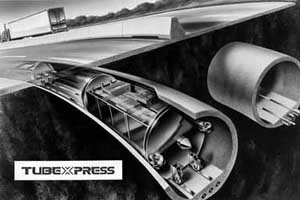Capsule pipelines may be applied to both passenger and freight movements. Most historic, existing and proposed applications are for freight transport.
Uses

William Vandersteel's current Tubexpress proposal for inter-city freight movement. Installation is under an existing highway (Source: Tubexpress).
Small diameter pneumatic capsule pipelines were used to transport telegrams and telegraph messages in Western Europe and North America from around 1850. Most of these systems fell out of use in the second half of the 20th century. Small diameter systems are still used to transfer small freight items over short distances. Common applications involve moving cash from supermarket tills to backroom offices.
Larger diameter pneumatic systems were developed by the Victorians as an alternative to underground railways, carrying freight and passengers underground in cities. During the 1960s and 1970s large diameter pneumatic systems were further developed as a potential technology for high speed ground transportation. Recent proposed applications range from the distribution of household goods, mail or refuse, to inter-city or inter-continental freight movement. Movement of passengers might also be possible.
New technology and greater environmental awareness are making the economics of capsule pipelines more attractive. Capsule pipelines may provide a viable alternative to many existing road and rail based transport movements. The difficulty in financing and developing extensive networks means the most successful proposals and applications are in niche markets, such as cash movements within supermarkets, or movement of coal. Potential exists for capsule pipelines to be applied to almost any earth-based transport movement.